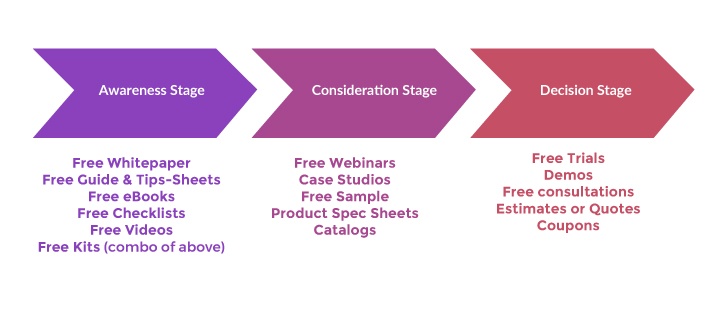Lead generation is one of the main process in the inbound marketing methodology; it is the activity through which you can attract and convert visitors and prospects into leads, that means ready to be contacted from your sales department.
When a visitor comes to your website you have to provide him with a useful and free content in order to grab his attention. You have to build for him a valid path that starts with a call to action and ends when people fill out a signup form, leaving you a contact information.
In this article you will get acquainted with the lead generation process and you will find out how you can handle it easily using a software like HubSpot.
The lead generation process

As mentioned above you have to create a path for your visitors in order to build a trustworthy relationship with him and to encourage him to leave you his contact information.
How can you do that? The lead generation process is articulated around different steps:
- CTA (Call-to-action)
- Landing Page
- Offer
- Personal Info
- Lead
Call-to-action
The first step of this conversion is the CTA. The role of the CTA is to tempt people to push the button in order to redirect them to a specific landing page containing the offer you have set for them and to make them fill the form with their personal information.
CTA can be used on product pages, display ads, emails, social media, direct emails.
In order to create a very prominent call to action you must follow these practices:
- a good call to action must contain few words;
- the verb you use is very important in order to make it clear for visitors which action they have to take and the result of that action.
When it’s easy to understand the benefits of the products or services and their features, you can place it at the top of the page; otherwise, if the call to action refers to a new product or service, it’s better to place it at the end of the page after rich content, so that the visitor is able to understand its benefits and features.
A call to action must invite your visitors to accomplish a specific task:
- Download this ebook
- Sign up to our newsletter
- Register for our webinar
You can use it for the following resources:
- Webinar
- White papers and reports
- Ebook
- Research studies
- A free class, demo or trial offers
“Once a visitor has landed on your website, he needs to find a useful and free content. Otherwise? Well, he’ll go somewhere else! Tweet
HubSpot CTAs
HubSpot provides you with a good template for your CTA: you can design your CTA and customize it by uploading an image for your button, changing the button content, style and colours. It’s very simple and you don’t need to be a designer to create a very good CTA.
Hubspot Lead Flow
Hubspot enables you to create a Lead Flow in very few simple steps:
Choose the following voice “Lead Flow” from the main navigation menu:
- Marketing
- Lead capture
- Lead flow.
Then select the tab Type and choose where to show the CTA and its position:
- Pop up box
- Drop down banner
- Slide in box left
- Slide in box right
In the section “Callout” you can choose an image for your CTA and you can add a text using a simple text editor.
Clicking on the tab “Form” you can add the consent notice and choose the language.
The section “follow-up” enables you to send an email after the user has registered to your newsletter.
Thanks to the Preview tab you can see how your CTA appears on the displays of different devices,such as computer desktop, tablets, smartphones.
2. Landing page
The use of a landing page enables you to direct your visitors to a specific offer without distractions. Remember that the purpose of your landing page is only one: to make people fill the form with their personal information.
How to build a landing-page
A landing page must have the following structure:
- Headline
- Brief description of the offer
- Supporting image/images
- Form to capture information
A good landing page is without the main navigation menu; remember, no distractions for your visitors. The main navigation could encourage him to go elsewhere before he fills the form and you can lose the chance to convert him into a lead.
Pay special attention to the headline because it should match the sentence of the CTA: if the headline and the CTA send different messages, it could confuse the visitor and encourage him to abandon the page.
Hubspot Landing Pages

Hubspot enables you to create and test a good landing page thanks to the following features:
Preview: the preview allows you to see how the landing page appears on different devices.
Dashboard: this function enables you to create a dashboard through which you can organize the landing pages, categorizing them by name, campaign, date of the last update.
A/B Test: Hubspot enables you to test every element of your landing page, title, images, CTA, different graphics in order to help you to choose the most performing version.
You can measure your landing pages performances; for example,you can easily understand which of your landing pages is generating a huge amount of leads and which one you need to change.
3. Offer
Your offer has to be enticing i.e. exclusive and scarce or high in demand. Your offer could consist in whitepapers, a free trial, a membership, a sales promotion, a download. If it is enticing your visitors will be ready to give you their personal information in order to obtain it.
The element of scarcity, time or quantity, is one of the most compelling strategy to persuade the visitors to fill a form in order to obtain the resource they will.
Not all prospects are at the same stage of the buying cycle: for this reason you have to provide personalized offers: for example, people at the top of the buying cycle are looking for informational resources, such as guides or ebooks, while someone in the middle of the funnel might be more interested in a free trial or a demo. You can create offers for each stage and a primary and secondary CTA for these offers and put it in different pages of your website.
Example: Gardening an activity to be carried out throughout the year

Your company sells gardening equipment. Someone who is searching on Google some suggestions about gardening, has landed on your blog. He reads the blog post “ Gardening: an activity to be carried out throughout the year” and at the end of the blog he founds the CTA you have set on Hubspot as shown in the paragraph above “download our complete guide about pruning and grafts” and click on it.
After the visitor registration, Hubspot enrolled him into a list you have created before, which contains “leads who download the guide”. According to Hubspot workflow this lead will receive an email two weeks later with useful information about gardening.
When the lead will find your email in his inbox email he will not delete it because will find it quite interesting.
Conclusions
As I mentioned before, in order to obtain your visitors personal information you should provide a high value offer. The value of your offer could depend on the format you choose: some formats obtain a better response from people than others.
How can you decide which is the best choice for your audience? You have to test it with your audience in order to understand which is the right offer.
As you can see there’s a big difference between the inbound marketing and the traditional marketing strategy. The inbound marketing before making a sales call to someone who has indicated interest in a product or a service, tries to inform and to educate him with free and helpful resources.
The traditional marketing strategy skips this important step instead – in which you nurture the lead with useful information – and goes directly to the last step of the buying cycle, the call from the sales department.
While the inbound marketing is based on a trustworthy relationship between lead, prospect and customer with a company, the traditional marketing proves to be interruptive and intrusive.
This kind of methodology is gradual because it goes at the same pace of the customer journey, it respects every stage of the buying cycle and it’s based on the full comprehension of the customer’s needs and pains. It takes more time than traditional marketing but it’s undoubtedly more rewarding.
Wanna know if HubSpot is the right software for your business?
Ask us. It’s free!

